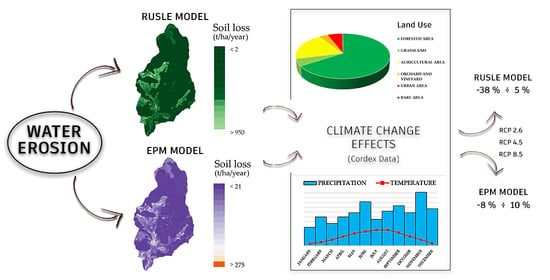Water Soil Erosion Evaluation in a Small Alpine Catchment Located in Northern Italy: Potential Effects of Climate Change
Abstract
:1. Introduction
2. Material and Methods
2.1. Study Area: The Guerna Catchment
2.2. Empirical Models
2.3. Climate Change Scenarios
- Driving model or Global Climate Model (GCM): a GCM can provide projections of how the earth’s climate may change in the future, on grid cells of around 1000 by 1000 km, and it is based on mathematical descriptions of the governing physical processes of the climate system. A GCM cannot supply an accurate representation of localized extreme events, but it drives the Regional Climate Model (RCM), incorporating the input domain for an RCM [23]. In this analysis, the selected GCM was the ICHEC-EC-EARTH [40].
- Regional Climate Model (RCM): The Regional Climate Model (RCM) is driven by the GCM; it can provide information on much higher spatial resolution because it is applied over a limited area. CORDEX data were calculated using RCM together with the dynamical downscaling technique [22,41]. In this work, the selected RCM was RCA4 (the surface processes of the Rossby Centre regional atmospheric climate model), described by the report of [42].
- Domain: a domain is a region where the regional downscaling takes place, and there are 14 different CORDEX domains. The European domain (EURO) covers the whole European continent. In this work, the domain used was EUR-11i, which has a resolution of 0.125 degrees, both in latitude and in longitude [41].
2.4. The Impact of Climate Change: Application of RUSLE Model
2.5. The Impact of Climate Change: Application of EPM Model
2.6. The Effect of Climate Change on Land Use
3. Results
3.1. The Impact of Climate Change According to the RUSLE Model
- RCP 2.6 scenario: R factor = 2460 MJ·mm/(ha·h·year)
- RCP 4.5 scenario: R factor = 1453 MJ·mm/(ha·h·year)
- RCP 8.5 scenario: R factor = 2147 MJ·mm/(ha·h·year)
3.2. The Impact of Climate Change According to the EPM Model
- RCP 2.6 scenario: H = 1300.2 mm/(year)
- RCP 4.5 scenario: H = 1101.1 mm/(year)
- RCP 8.5 scenario: H = 1299.6 mm/(year).
- RCP 2.6 scenario: T = 1.15
- RCP 4.5 scenario: T = 1.18
- RCP 8.5 scenario: T = 1.21.
3.3. Comparison with the Scenario without Climate Change
4. Discussions
5. Conclusions
Author Contributions
Funding
Conflicts of Interest
References
- Li, Z.; Fang, H. Impacts of climate change on water erosion: A review. Earth Sci. Rev. 2016, 163, 94–117. [Google Scholar] [CrossRef]
- Stocker, T.F.; Qin, D.; Plattner, G.; Tignor, M.M.B.; Allen, S.K.; Boschung, J.; Nauels, A.; Xia, Y.; Bex, V.; Midgley, P.M. IPCC 2013. In Climate Change 2013: The Physical Science Basis. Contribution of Working Group I to the Fifth Assessment Report of the Intergovernamental Panel on Climate Change; Cambridge University Press: Cambridge, UK; New York, NY, USA, 2013; 1585p. [Google Scholar]
- Prusky, F.F.; Nearing, M.A. Runoff and soil-loss responses to changes in precipitation: A computer simulation study. J. Soil Water Conserv. 2002, 57, 7–16. [Google Scholar]
- Routschek, A.; Schmidt, J.; Kreienkamp, F. Impact of climate change on soil erosion – a high resolution projection on catchment scale until 2100 in Saxony/Germany. Catena 2014, 121, 99–109. [Google Scholar] [CrossRef]
- Nearing, M.A.; Jetten, V.; Baffaut, C.; Cerdan, O.; Couturier, A.; Hernandez, M.; Le Bissonnais, Y.; Nichols, M.H.; Nunes, J.P.; Renschler, C.S.; et al. Modeling response of soil erosion and runoff to changes in precipitation and cover. Catena 2005, 61, 131–154. [Google Scholar] [CrossRef]
- Nearing, M.A.; Prusky, F.F.; O’Neal, M.R. Expected climate change impacts on soil erosion rates: A review. J. Soil Water Conserv. 2004, 59, 43–50. [Google Scholar]
- Le Van, T.; Ranzi, R.; Rulli, M.C. Modeling Soil Erosion and Sediment Load for Red River Basin (Vietnam): Impact of Land Use Change and Reservoirs Operation. In Proceedings of the 2018 IEEE International Conference on Environment and Electrical Engineering and 2018 IEEE Industrial and Commercial Power Systems Europe (EEEIC/I&CPS Europe), Palermo, Italy, 12–15 June 2018. [Google Scholar]
- Ranzi, R.; Le, T.H.; Rulli, M.C. A RUSLE approach to model suspended sediment load in the Lo river (Vietnam): Effects of reservoirs and land use changes. J. Hydrol. 2012, 422–423, 17–29. [Google Scholar] [CrossRef]
- Nunes, J.P.; Seixas, J.; Keizer, J.J. Modeling the response of within-storm runoff and erosion dynamics to climate change in two Mediterranean watershed: A multi-model, multi-scale approach to scenario design and analysis. Catena 2013, 102, 27–39. [Google Scholar] [CrossRef]
- Ricci, G.F.; Jeong, J.; De Girolamo, A.M.; Gentile, F. Modelling management practices to reduce soil erosion in an agricultural watershed in Southern Europe. In Proceedings of the SWAT Conference, Brussels, Belgium, 17–21 September 2018. [Google Scholar]
- Li, Z.; Liu, W.Z.; Zhang, X.C.; Zheng, F.L. Assessing the site-specific impacts of climate change on hydrology, soil erosion and crop yields in the Loess Plateau of China. Clim. Chang. 2011, 105, 223–242. [Google Scholar] [CrossRef]
- Salazar, S.; Francés, F.; Komma, J.; Blume, T.; Francke, T.; Bronstert, A.; Blöschl, G. A comparative analysis of the effectiveness of flood management measures based on the concept of “retaining water in the landscape” in different European hydroclimatic regions. Nat. Hazard. Earth Sys. 2012, 12, 3287–3306. [Google Scholar] [CrossRef] [Green Version]
- De Vente, J.; Poesen, J. Predicting soil erosion and sediment yield at the basin scale: Scale issues and semi-quantitative models. Earth Sci. Rev. 2015, 71, 95–125. [Google Scholar] [CrossRef]
- Renard, K.G.; Foster, G.R.; Weesies, G.A.; Porter, J.P. RUSLE Revised universal soil loss equation. J. Soil Water Conserv. 1991, 46, 30–33. [Google Scholar]
- Gavrilovic, Z. The use of an empirical method (Erosion Potential Method) for calculating sediment production and transportation in unstidied or torrential streams. In International Conference River Regime; Jhon Wiley & Sons: Chichester, UK, 1988; pp. 411–422. [Google Scholar]
- Fowler, H.J.; Blenkinsop, S.; Tebaldi, C. Linking climate change modelling to impacts studies: Recent advances in downscaling techniques for hydrological modelling. Int. J. Climatol. 2007, 27, 1547–1578. [Google Scholar] [CrossRef]
- Nakicenovic, N.; Swart, R. Special Report on Emissions Scenarios: A Special Report of Working Group III of the Intergovernmental Panel on Climate Change; Cambridge University Press: Cambridge, UK, 2000; ISBN 0-521-80493-0. [Google Scholar]
- The Core Writing Team; Pachauri, R.K.; Reisinger, A. IPCC 2007: Climate Change 2007: Synthesis Report. Contribution of Working Groups I, II and III to the Fourth Assessment Report of the Intergovernmental Panel on Climate Change; IPCC: Geneva, Switzerland, 2007; p. 104. [Google Scholar]
- Bosco, C.; Rusco, E.; Montanarella, L.; Oliveri, S. Soil erosion risk assessment in the alpine area according to the IPCC scenarios. In Threats to Soil Quality in Europe; Toth, G., Montanarella, L., Rusco, E., Eds.; Joint Research Centre in Ispra: Cadrezzate (VA), Italy, 2008; pp. 47–58. Available online: http://publications.jrc.ec.europa.eu/repository/handle/JRC46574 (accessed on 27 May 2020). [CrossRef]
- Confortola, G.; Soncini, A.; Bocchiola, D. Climate change will affect hydrological regimes in the Alps. J. Alp. Res. Rev. de Géographie Alp. 2013, 101. [Google Scholar] [CrossRef] [Green Version]
- Berteni, F. Sediment Yield and Transport: Estimation and Climate Influence. Ph.D. Thesis, University of Brescia, Brescia, Italy, 5 March 2019. [Google Scholar]
- CORDEX–Coordinated Regional Climate Downscaling Experiment. Available online: http://www.cordex.org/ (accessed on 27 May 2020).
- Benestad, R.; Haensler, A.; Hennemuth, B.; Illy, T.; Jacob, D.; Keup-Thiel, E.; Kotlarsky, S.; Nikulin, G.; Otto, J.; Rechid, D.; et al. Guidance for EURO-CORDEX Climate Projections Data Use, Version 1.0. August 2017, Published by EURO-CORDEX community. Available online: https://www.euro-cordex.net/imperia/md/content/csc/cordex/euro-cordex-guidelines-version1.0-2017.08.pdf (accessed on 24 August 2020).
- Geoportale della Lombardia. Available online: http://www.geoportale.regione.lombardia.it (accessed on 27 May 2020). (In Italian).
- Consorzio dell’Oglio. Available online: http://www.oglioconsorzio.it (accessed on 27 May 2020). (In Italian).
- ARPA Lombardia. Available online: http://www.arpalombardia.it/Pages/ARPA_Home_Page.aspx (accessed on 27 May 2020). (In Italian).
- Bandini, A. Tipi Pluviometrici Dominanti Sulle Regioni Italiane; Ministero dei Lavori Pubblici: Roma, Italy, 1931. (In Italian) [Google Scholar]
- Barontini, S.; Grossi, G.; Kouwen, N.; Maran, S.; Scaroni, P.; Ranzi, R. Impacts of climate change scenarios on runoff regimes in the southern Alps. Hydrol. Earth Syst. Sci. Discuss. 2009, 6, 3089–3141. [Google Scholar] [CrossRef] [Green Version]
- Dominici, R.; Campolo, F.; Ferrari, P.; Modaffari, D. Tecniche per lo studio dell’analisi dell’erosione costiera con metodologie fotogrammetriche e telerilevate. In Proceedings of the Conferenza ASITA, Milan Polytechnic, Lecco, Italy, 29 September–1 October 2015. (In Italian). [Google Scholar]
- Efthimiou, N.; Lykoudi, E. Soil erosion estimation using the EPM model. Bull. Geol. Soc. Greece 2016, 50, 305–314. [Google Scholar] [CrossRef] [Green Version]
- Brown, L.C.; Foster, G.R. Storm erosivity using idealized intensity distribution. Trans. ASAE 1987, 30, 379–386. [Google Scholar] [CrossRef]
- Wischmeier, W.H.; Smith, D.D. Predicting Rainfall-Erosion Losses—A Guide to Conservation Planning; U.S. Department of Agriculture: Washington, DC, USA, 1978; Agr. Handbook, n.537.
- Borrelli, P.; Diodato, N.; Panagos, P. Rainfall erosivity in Italy: A national scale spatio-temporal assessment. Int. J. Digit. Earth 2016, 9, 835–850. [Google Scholar] [CrossRef] [Green Version]
- Panagos, P.; Borrelli, P.; Meusburger, K.; Yu, B.; Klik, A.; Lim, K.J.; Yang, J.E.; Ni, J.; Miao, C.; Chattopadhyay, N.; et al. Global rainfall erosivity assessment based on high-temporal resolution rainfall records. Sci. Rep. 2017, 7. [Google Scholar] [CrossRef] [Green Version]
- Bosco, C.; Oliveri, S. Chapter 3: Case studies. In Climate Change, Impacts and Adaptation Strategies in the Alpine Space, Strategic INTERREG III B Project CLIMCHALP, Natural Hazard Report; Centro Euro-Mediterraneo sui Cambiamenti Climatici: Lecce, Italy, 2007. [Google Scholar]
- Romkens, M.J.M.; Prased, S.N.; Poesen, J.W.A. Soil Erodibility and Properties. In Proceedings of the Transaction of the XIII Congress of the International Society of Soil Sciences, Hamburg, Germany, 13–20 August 1986; pp. 492–504. [Google Scholar]
- Renard, K.G.; Foster, G.R.; Weesies, G.A.; McCool, D.K.; Yoder, D.C. Predicting Soil Erosion by Water: A Guide to Conservation Planning with the Revised Universal Soil Loss Equation (RUSLE); U.S. Department of Agriculture: Washington, DC, USA, 1997; USDA Agr. Handbook, n.703.
- Moore, I.; Burch, G. Physical basis of the length-slope factor in the universal soil loss equation. Soil Sci. Soc. Am. J. 1986, 50, 1294–1298. [Google Scholar] [CrossRef]
- Nearing, M.A. A single, continuous function for slope steepness influence on soil loss. Soil Sci. Soc. Am. J. 1997, 61, 917–919. [Google Scholar] [CrossRef]
- EC-Earth-A European community Earth-System Model. Available online: http://www.ec-earth.org/ (accessed on 27 May 2020).
- ENES Portal – European Network for Earth System Modelling. Available online: https://portal.enes.org/ (accessed on 27 May 2020).
- Samuelsson, P.; Gollvik, S.; Jansson, C.; Kupiainen, M.; Kourzeneva, E.; Van De Berg, W.J. The Surface Processes of the Rossby Centre Regional Atmospheric Climate Model (RCA4); SMHI: (Sveriges Meteoroloska och Hydrologiska Insitut): Norrköping, Sweden, 2015; METEOROLOGI Nr 157.
- Il Meteo. Available online: http://www.ilmeteo.it/portale/archivio-meteo/Sarnico (accessed on 3 August 2020). (In Italian).
- Efthimiou, N.; Likoudi, E.; Panagoulia, D.; Karavitis, C. Assessment of soil susceptibility to erosion using the EPM and RUSLE models: The case of Venetikos river catchment. Glob. NEST J. 2016, 18, 164–179. [Google Scholar]
- Gianinetto, M.; Aiello, M.; Vezzoli, R.; Polinelli, F.N.; Rulli, M.C.; Chiarelli, D.D.; Bocchiola, D.; Ravazzani, G.; Soncini, A. Future scenarios of soil erosion in the Alps under climate change and land cover transformations simulated with automatic machine learning. Climate 2020, 8, 28. [Google Scholar] [CrossRef] [Green Version]
- Aiello, M.; Gianinetto, M.; Vezzoli, R.; Rota Nodari, F.; Polinelli, F.; Frassy, F.; Rulli, M.C.; Ravazzani, G.; Corbari, C.; Soncini, A.; et al. Modelling soil erosion in the Alps with dynamic RUSLE-like model and satellite observations. In Earth Observation Advancements in a Changing World, Proceedings of the Italian Society of Remote Sensing Conference, Florence, Italy, 4–6 July 2018; AIT: Florence, Italy, 2018; Volume 23, pp. 94–97. [Google Scholar]
- Gianinetto, M.; Aiello, M.; Polinelli, F.N.; Frassy, F.; Rulli, M.C.; Ravazzani, G.; Bocchiola, D.; Chiarelli, D.D.; Soncini, A.; Vezzoli, R. D-RUSLE: A dynamic model to estimate potential soil erosion with satellite time series in the Italian Alps. Eur. J. Remote Sens. 2019, 52, 34–53. [Google Scholar] [CrossRef]
- Gobiet, A.; Kotlarski, S.; Beniston, M.; Heinrich, G.; Rajczak, J.; Stoffel, M. 21st century climate change in the European Alps—A review. Sci. Total Environ. 2014, 493, 1138–1151. [Google Scholar] [CrossRef]
- Wang, L.; Shi, Z.H.; Wang, J.; Fang, N.F.; Wu, G.L.; Zhang, H.Y. Raifall kinetic energy controlling erosion processes and sediment sorting on steep hillslopes: A case study of clay loam soil from the Loess Plateau, China. J. Hydrol. 2014, 512, 168–176. [Google Scholar] [CrossRef]
- Xu, J. Sediment flux to the sea as influenced by changing human activities and precipitation: Example of the Yellow River, China. Environ. Manag. 2003, 31, 0328–0341. [Google Scholar]
- Zhu, A.L.; Wang, P.; Zhu, T.; Chen, L.; Cai, Q.; Liu, H. Modeling runoff and soil erosion in the Three-Gorge Reservoir drainage area of China using limited plot data. J. Hydrol. 2013, 492, 163–175. [Google Scholar] [CrossRef]
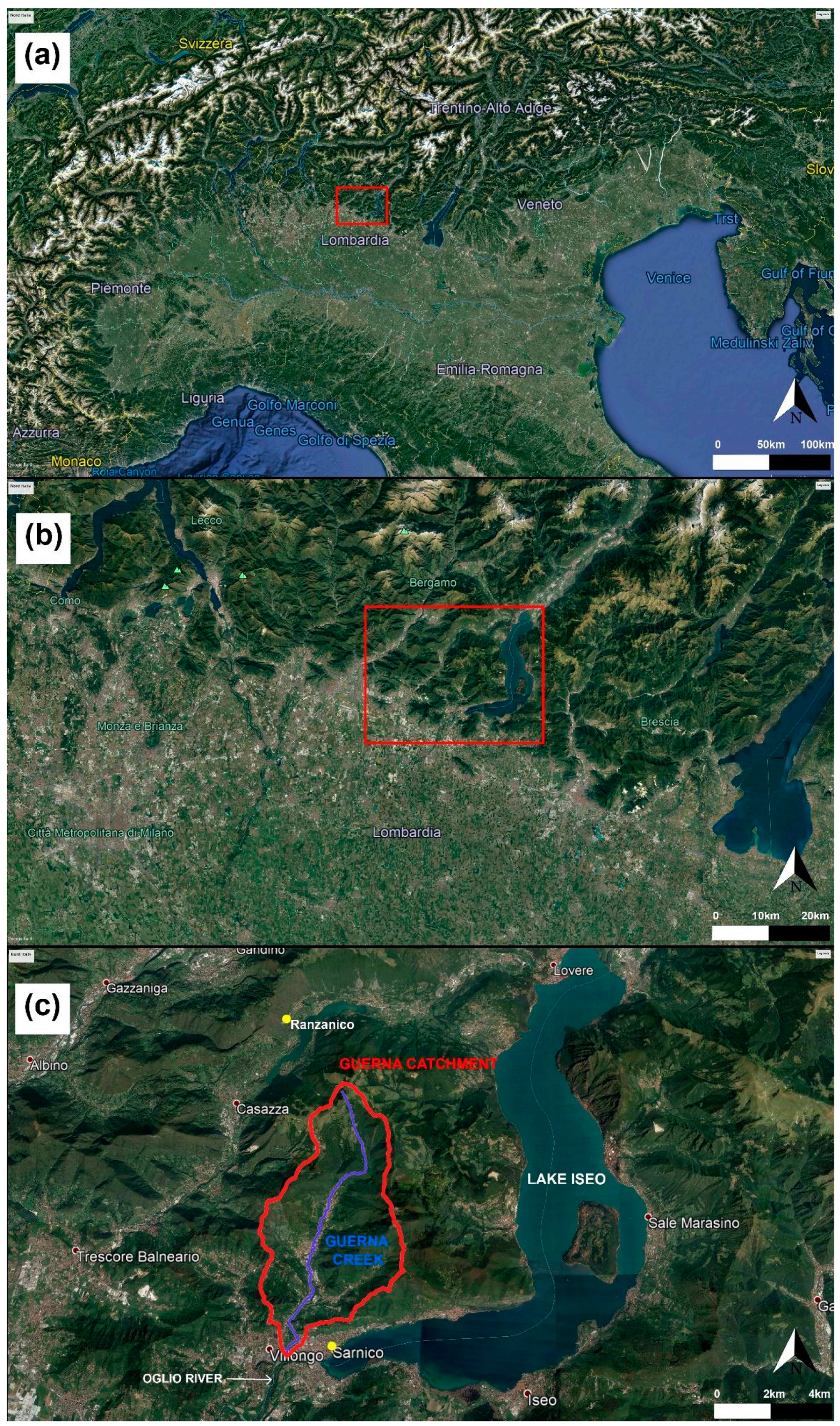
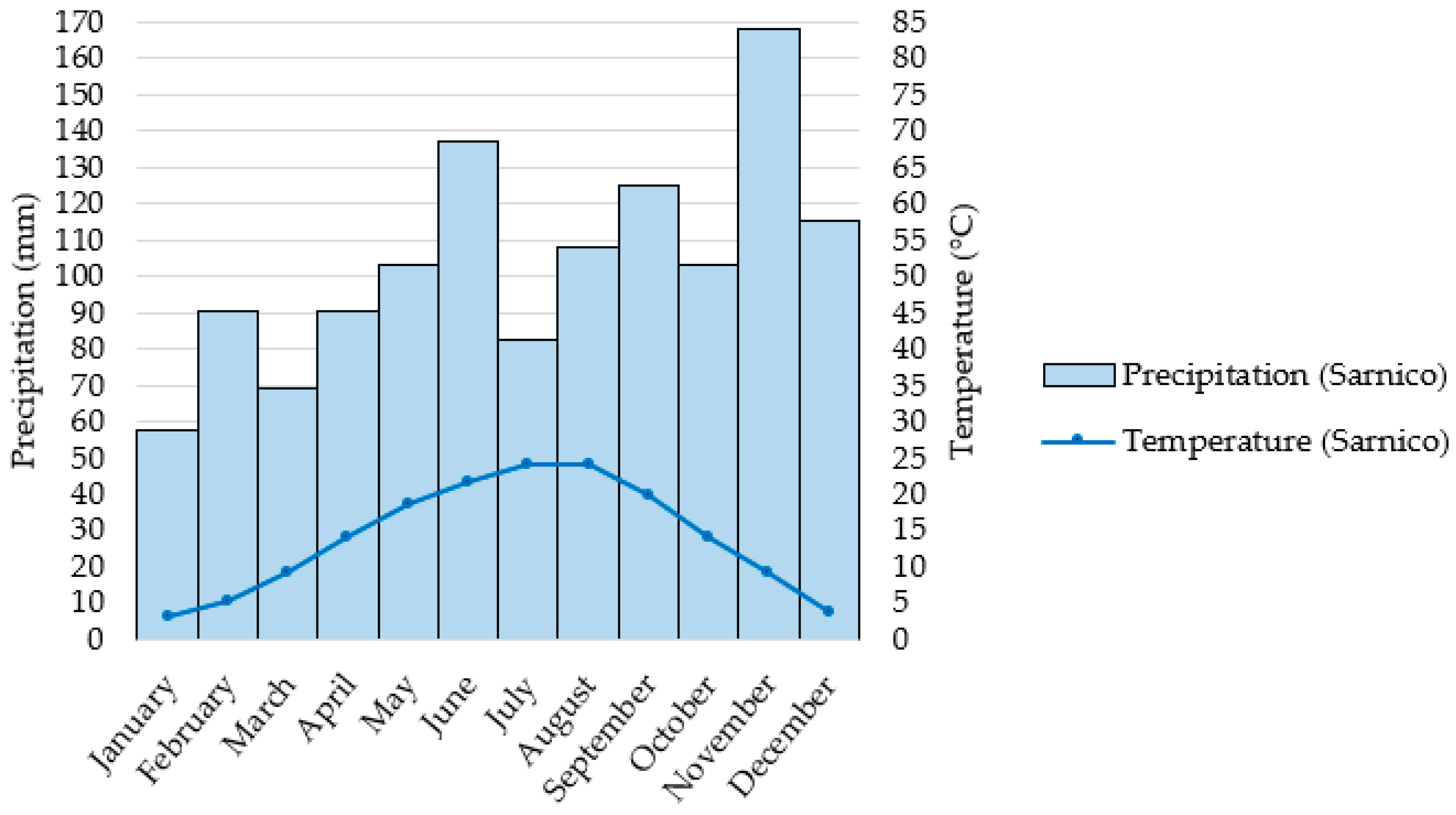


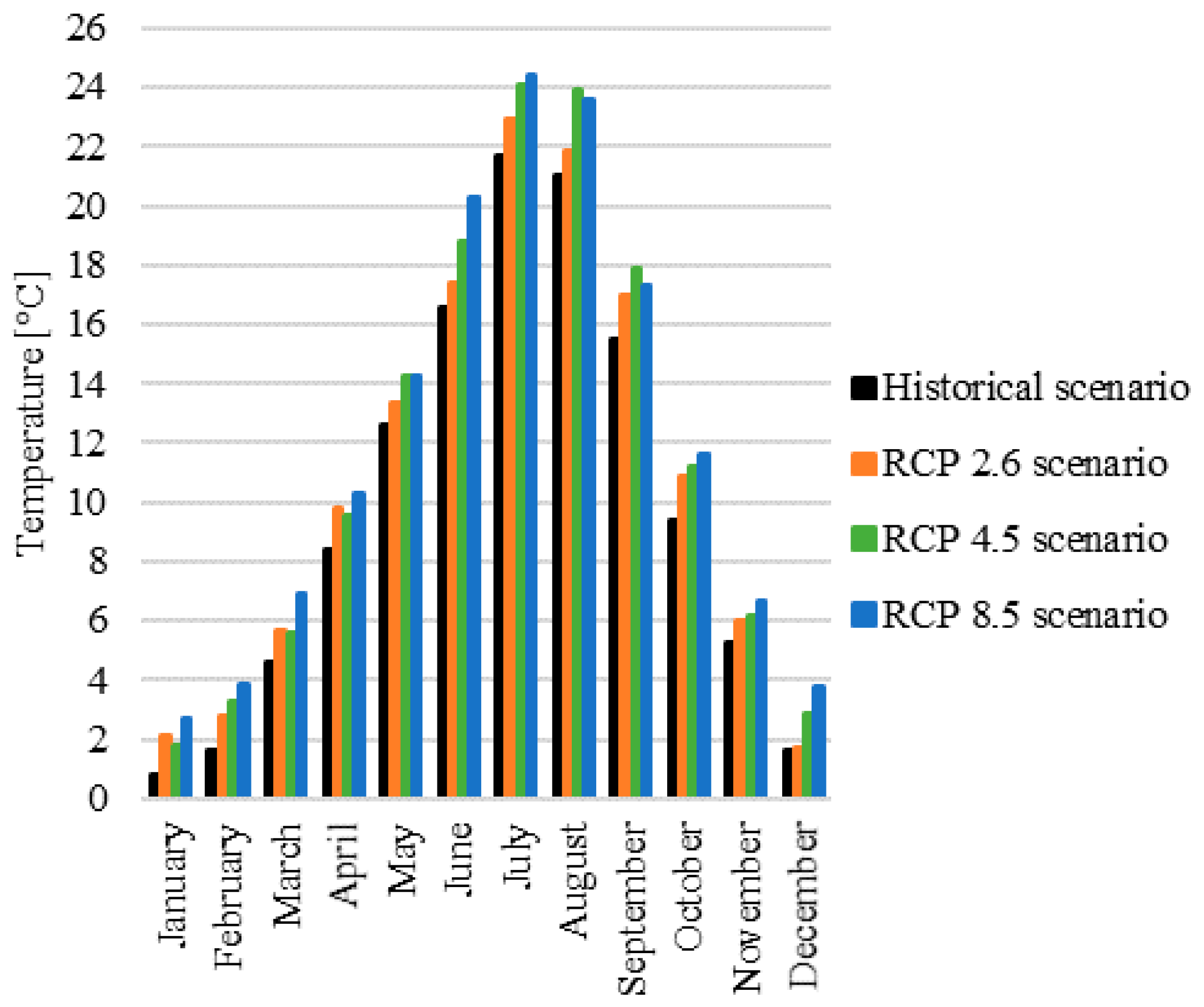


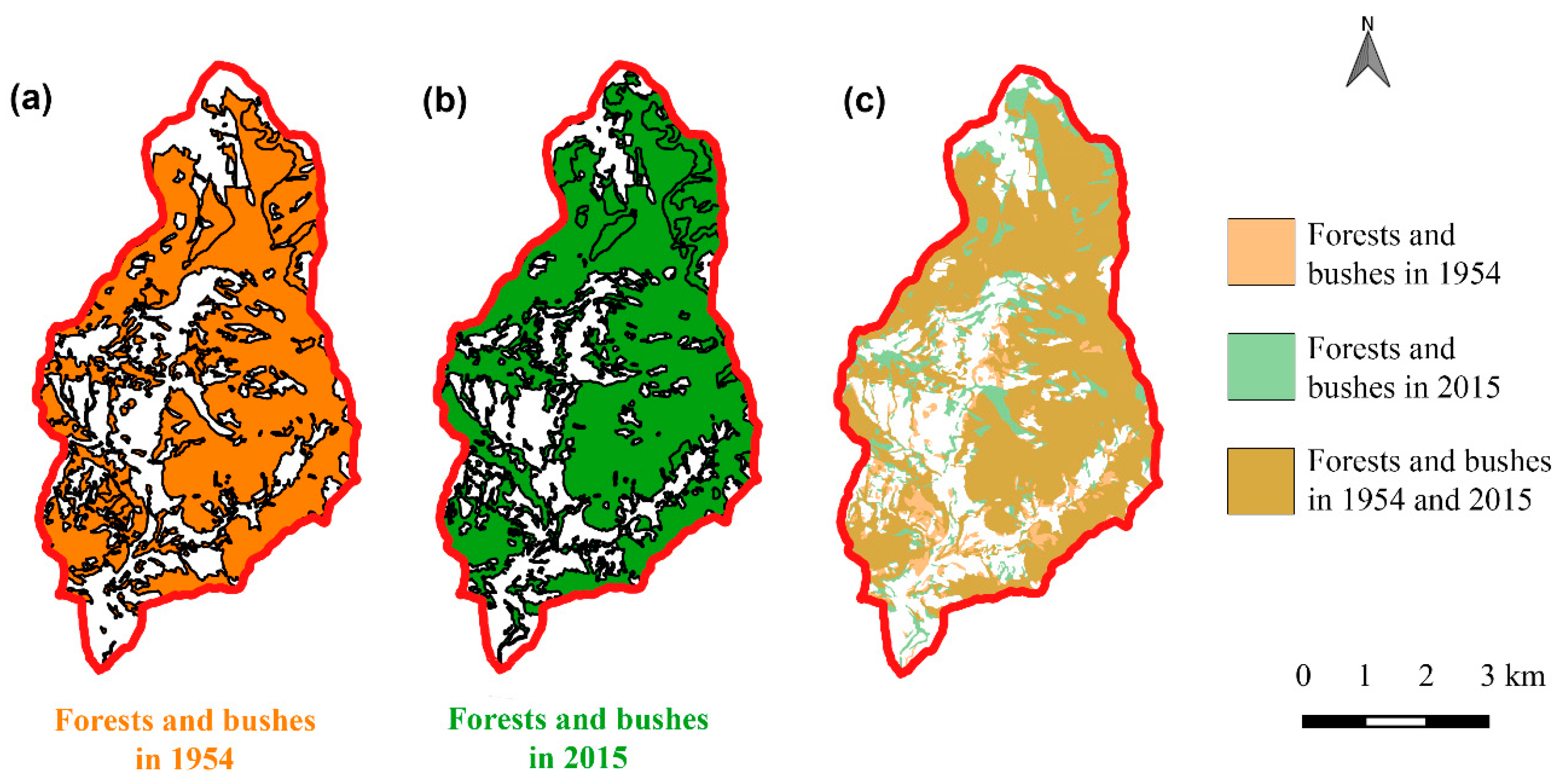
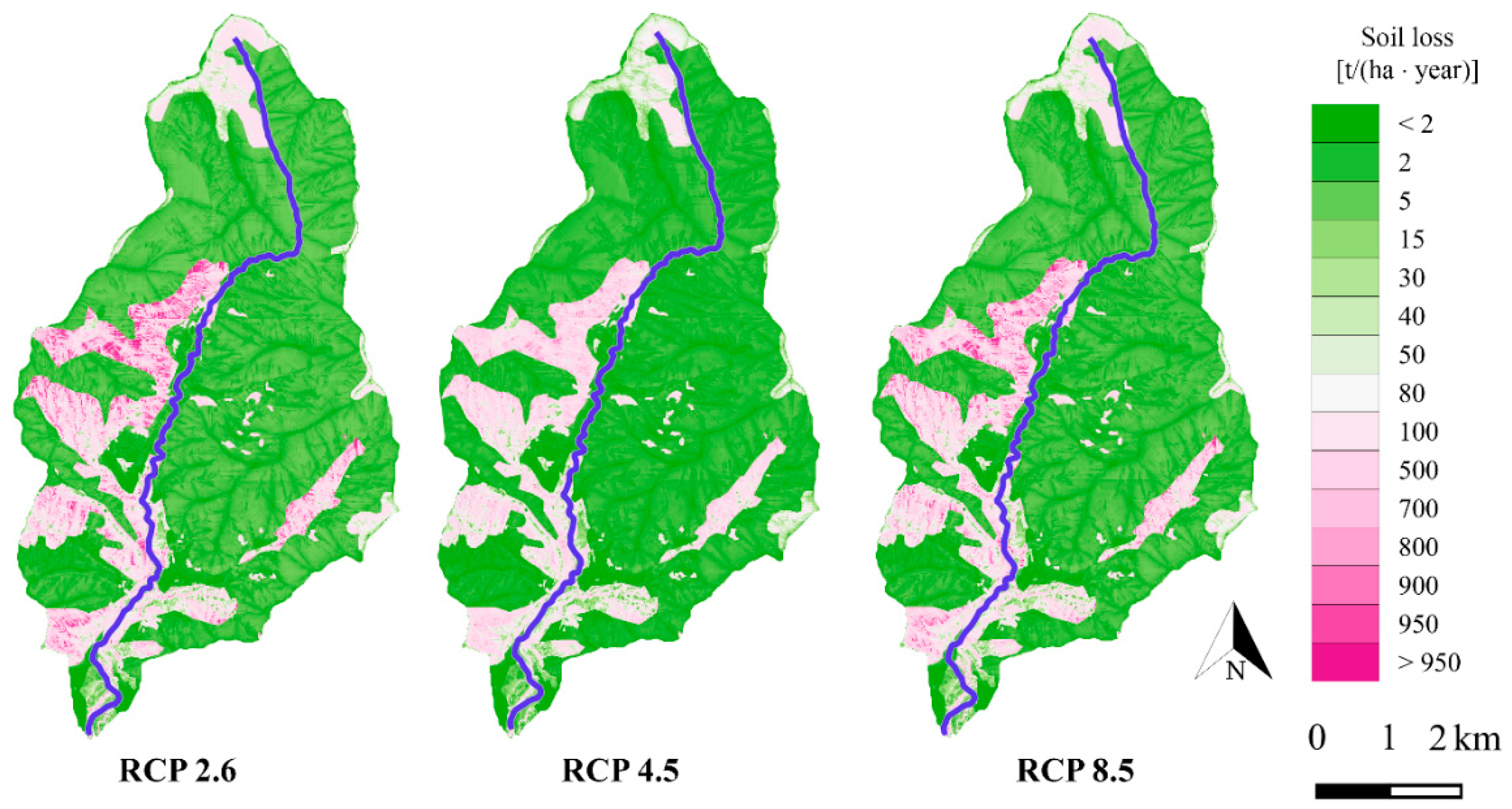
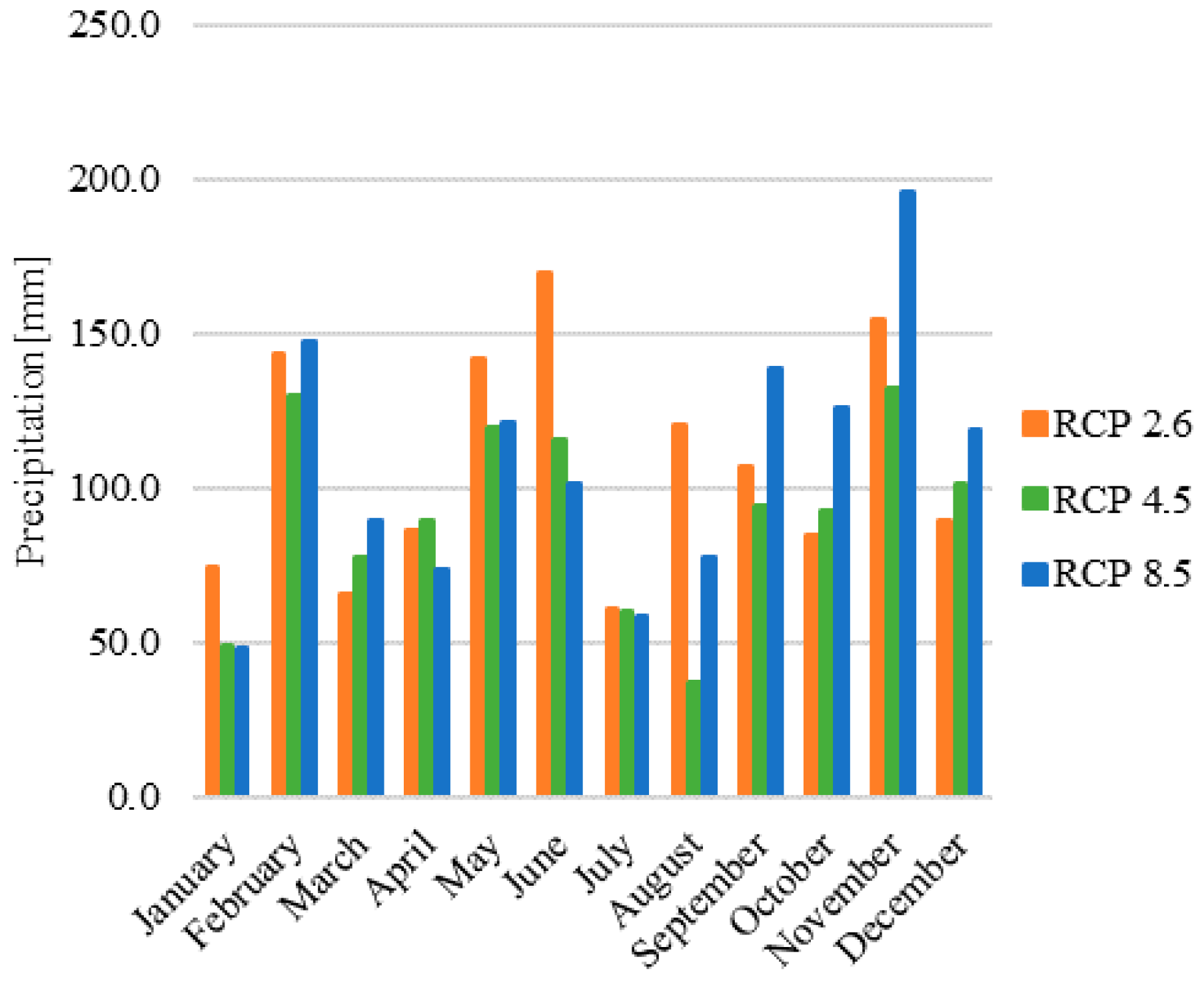
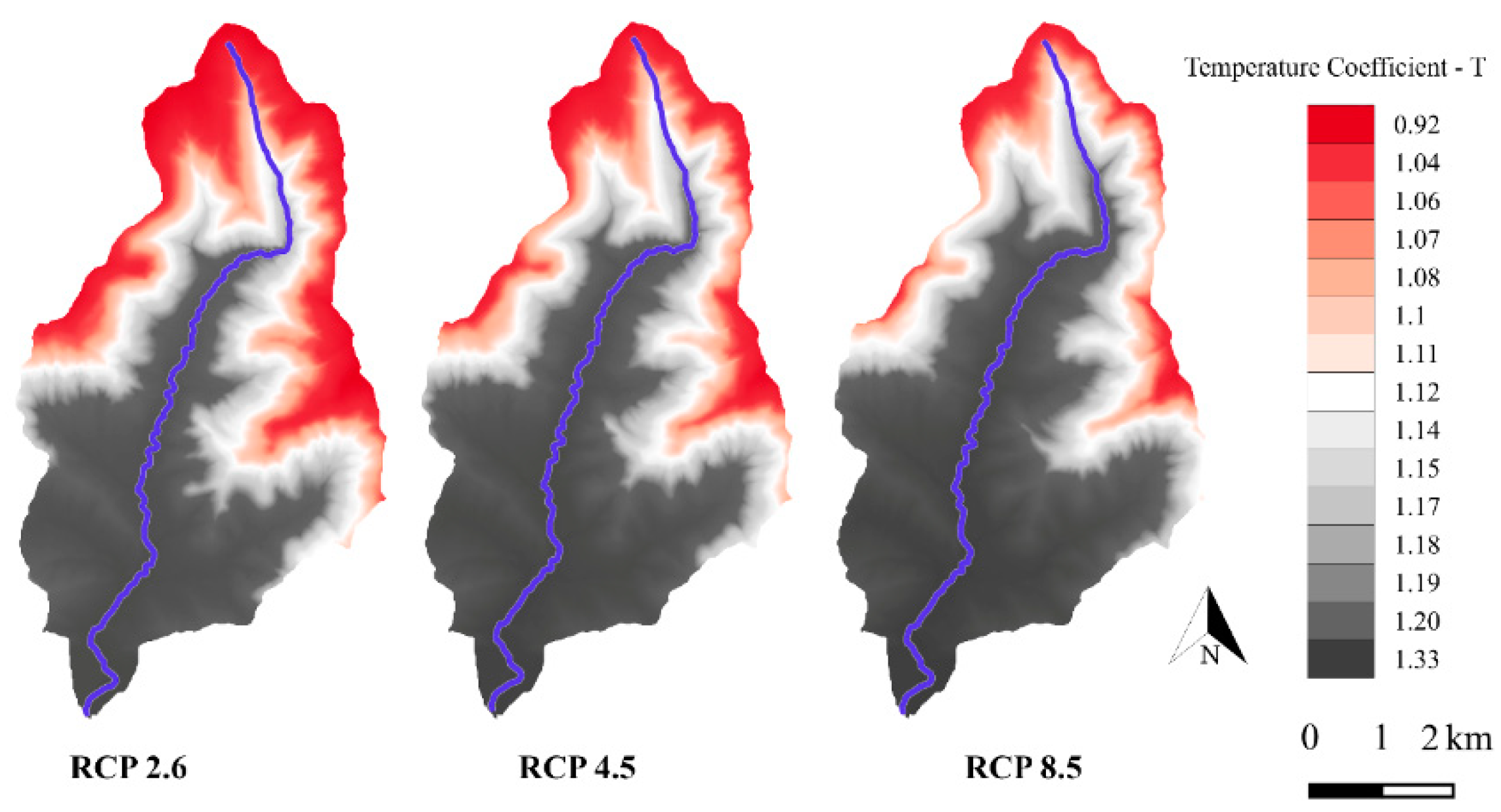
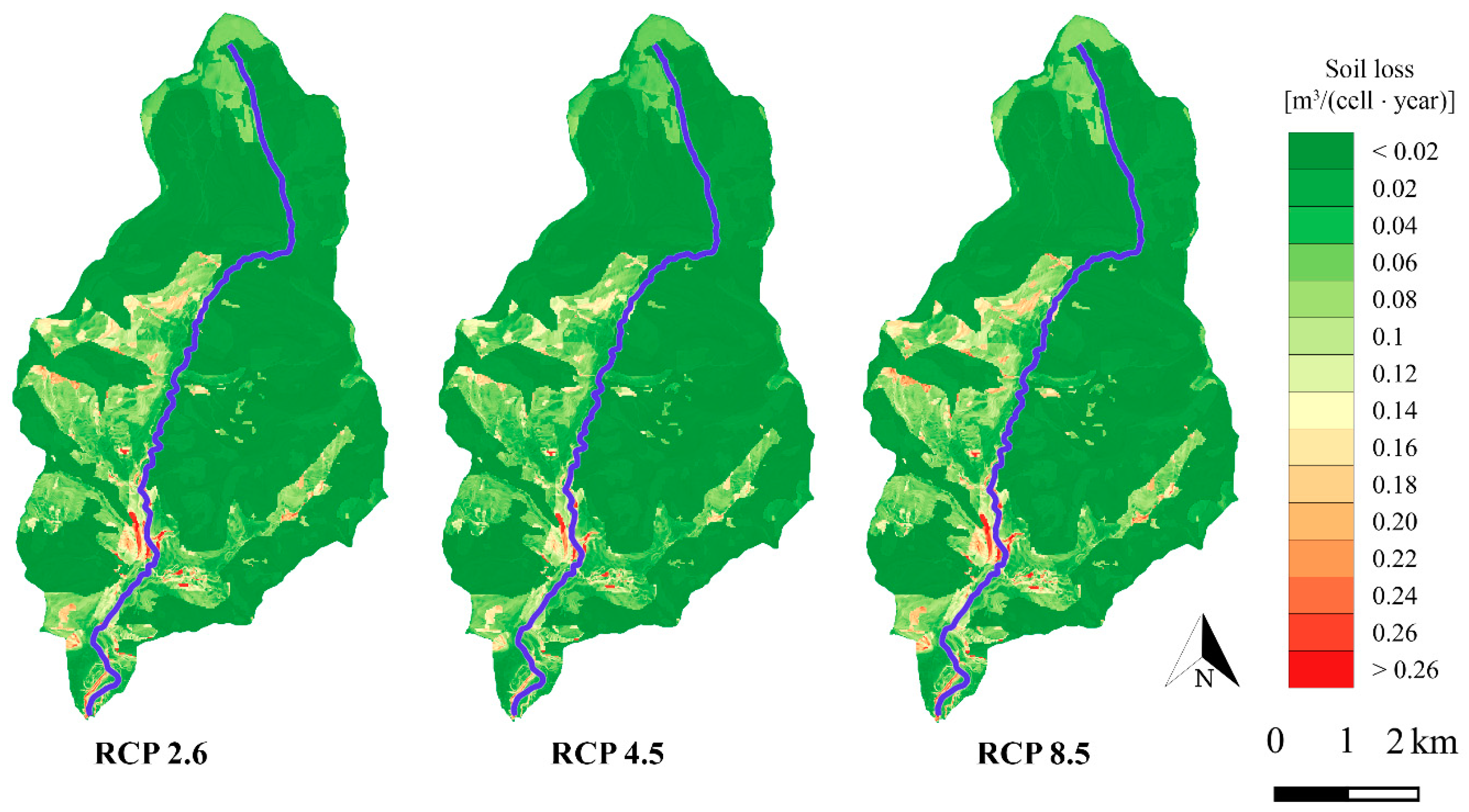
| Parameter | Value |
|---|---|
| Basin area [km2] | 31 |
| Wooded, reforested and forested area [km2] | 20.5 |
| Grassland [km2] | 1.64 |
| Agricultural area [km2] | 6.00 |
| Orchard and vineyard [km2] | 1.07 |
| Urban area [km2] | 1.83 |
| Bare areas [km2] | 0.05 |
| Average hillslope of the catchment area [%] | 51 |
| Maximum elevation [m a.s.l.] | 1332 |
| Minimum elevation [m a.s.l.] | 185 |
| Length of the main channel (Guerna creek) [km] | 12.3 |
| Longitudinal average slope of the main channel (Guerna creek) [m/m] | 0.07 |
| Mean annual precipitation at Sarnico station (years 2008–2011) 1 [mm] | 1250.6 |
| Mean annual temperature at Sarnico station (years 2008–2011) 2 [°C] | 13.9 |
| Sample Location of the Study Area | Xsk (%) 1 | fi (%) 2 | Soil Texture | ||
|---|---|---|---|---|---|
| Clay | Silt | Sand | |||
| Southern part | 46.68 | 22.90 | 38.48 | 38.62 | Loam |
| Northern part | 12.19 | 24.52 | 36.18 | 39.31 | Loam |
| Ji-month Coefficient [–] | Erosivity Index Re [MJ·mm·h−1·ha−1] | ||||||
|---|---|---|---|---|---|---|---|
| Month | RCP 2.6 Scenario | RCP 4.5 Scenario | RCP 8.5 Scenario | Current Climate | RCP 2.6 Scenario | RCP 4.5 Scenario | RCP 8.5 Scenario |
| January | 1.29 | 0.85 | 0.83 | 20.6 | 36 | 14.7 | 13.9 |
| February | 1.59 | 1.44 | 1.64 | 43.9 | 123.4 | 98.1 | 131 |
| March | 0.95 | 1.12 | 1.29 | 31.3 | 28 | 39.9 | 55.3 |
| April | 0.96 | 0.99 | 0.81 | 86.1 | 78.1 | 84.8 | 54.9 |
| May | 1.37 | 1.16 | 1.18 | 177.7 | 373.9 | 249.9 | 261.2 |
| June | 1.23 | 0.84 | 0.74 | 312.3 | 510.8 | 209.1 | 153.8 |
| July | 0.74 | 0.73 | 0.72 | 457.1 | 223.7 | 220.9 | 207.5 |
| August | 1.12 | 0.34 | 0.72 | 394.2 | 510.9 | 33.2 | 181.9 |
| September | 0.85 | 0.76 | 1.11 | 468.9 | 323 | 243.1 | 597.8 |
| October | 0.82 | 0.90 | 1.23 | 98.1 | 63.2 | 77.4 | 157 |
| November | 0.92 | 0.79 | 1.17 | 189.1 | 155.8 | 138.7 | 271.9 |
| December | 0.78 | 0.88 | 1.03 | 56.8 | 33 | 43.1 | 61 |
| Land Use | C Factor | P Factor |
|---|---|---|
| Wooded, reforested and forested area | 0.002 | 1 |
| Grassland | 0.07 | 1 |
| Agricultural area | 0.45 | 1 |
| Orchard and vineyard | 0.37 | 0.45 |
| Urban area | 0.003 | 1 |
| Bare areas | 0.36 | 1 |
| Month | Temperature Difference [°C] at Point A | ||
|---|---|---|---|
| RCP 2.6 Scenario | RCP 4.5 Scenario | RCP 8.5 Scenario | |
| January | 1.36 | 1.00 | 1.91 |
| February | 1.16 | 1.62 | 2.30 |
| March | 1.13 | 1.07 | 2.37 |
| April | 1.43 | 1.20 | 1.90 |
| May | 0.78 | 1.70 | 1.72 |
| June | 0.84 | 2.22 | 3.71 |
| July | 1.22 | 2.48 | 2.71 |
| August | 0.97 | 2.99 | 2.61 |
| September | 1.48 | 2.37 | 1.79 |
| October | 1.49 | 1.74 | 2.15 |
| November | 0.65 | 0.91 | 1.38 |
| December | 0.19 | 1.32 | 2.24 |
| Coefficient | Maximum Value | Minimum Value | Mean Value |
|---|---|---|---|
| (land use coefficient) | 0.90 | 0.13 | 0.29 |
| (coefficient of soil resistance to erosion) | 2.00 | 0.90 | 1.22 |
| (coefficient value for the observed erosion processes) | 0.90 | 0.15 | 0.30 |
| Z (coefficient of erosion) | 2.96 | 0.00 | 0.33 |
| Future Scenario | A_mean [t/(ha∙Year)] | A_tot [t/(Year)] |
|---|---|---|
| RCP 2.6 | 91.7 | 283,427.5 |
| RCP 4.5 | 54.2 | 167,406.6 |
| RCP 8.5 | 80.0 | 247,365.4 |
| Future Scenario | Wg_mean [m3/(Cell∙Year)] | Wg_tot [m3/(Year)] |
|---|---|---|
| RCP 2.6 | 0.029 | 36,358.0 |
| RCP 4.5 | 0.025 | 31,516.0 |
| RCP 8.5 | 0.030 | 37,881.5 |
| Method | Without Considering Climate Change Scenario | Climate Change Scenario | ||
|---|---|---|---|---|
| RCP 2.6 | RCP 4.5 | RCP 8.5 | ||
| RUSLE [t/year] | 269,141 | 283,428 | 167,407 | 247,365 |
| EPM [m3/year] | 34,193 | 36,358 | 31,516 | 37,882 |
| Scenario | RUSLE Results (A) [t/(ha∙Year)] | ||
|---|---|---|---|
| Maximum Value | Mean | Standard Deviation | |
| Without climate change | 1706.9 | 87.1 | 203.3 |
| RCP 2.6 | 1797.5 | 91.7 | 214.1 |
| RCP 4.5 | 1061.7 | 54.2 | 126.4 |
| RCP 8.5 | 1568.8 | 80.0 | 186.8 |
| Scenario | EPM Results (Wg) [m3/(Cell∙Year)] | ||
|---|---|---|---|
| Maximum Value | Mean | Standard Deviation | |
| Without climate change | 0.606 | 0.028 | 0.040 |
| RCP 2.6 | 0.664 | 0.029 | 0.043 |
| RCP 4.5 | 0.574 | 0.025 | 0.037 |
| RCP 8.5 | 0.686 | 0.031 | 0.045 |
| Method | Without Considering Climate Change Scenario | Climate Change Scenario | ||
|---|---|---|---|---|
| RCP 2.6 | RCP 4.5 | RCP 8.5 | ||
| RUSLE [t/year] | 269,141 | 283,428 | 167,407 | 247,365 |
| EPM [t/year] | 90,612 | 96,349 | 83,517 | 100,386 |
© 2020 by the authors. Licensee MDPI, Basel, Switzerland. This article is an open access article distributed under the terms and conditions of the Creative Commons Attribution (CC BY) license (http://creativecommons.org/licenses/by/4.0/).
Share and Cite
Berteni, F.; Grossi, G. Water Soil Erosion Evaluation in a Small Alpine Catchment Located in Northern Italy: Potential Effects of Climate Change. Geosciences 2020, 10, 386. https://doi.org/10.3390/geosciences10100386
Berteni F, Grossi G. Water Soil Erosion Evaluation in a Small Alpine Catchment Located in Northern Italy: Potential Effects of Climate Change. Geosciences. 2020; 10(10):386. https://doi.org/10.3390/geosciences10100386
Chicago/Turabian StyleBerteni, Francesca, and Giovanna Grossi. 2020. "Water Soil Erosion Evaluation in a Small Alpine Catchment Located in Northern Italy: Potential Effects of Climate Change" Geosciences 10, no. 10: 386. https://doi.org/10.3390/geosciences10100386
APA StyleBerteni, F., & Grossi, G. (2020). Water Soil Erosion Evaluation in a Small Alpine Catchment Located in Northern Italy: Potential Effects of Climate Change. Geosciences, 10(10), 386. https://doi.org/10.3390/geosciences10100386





